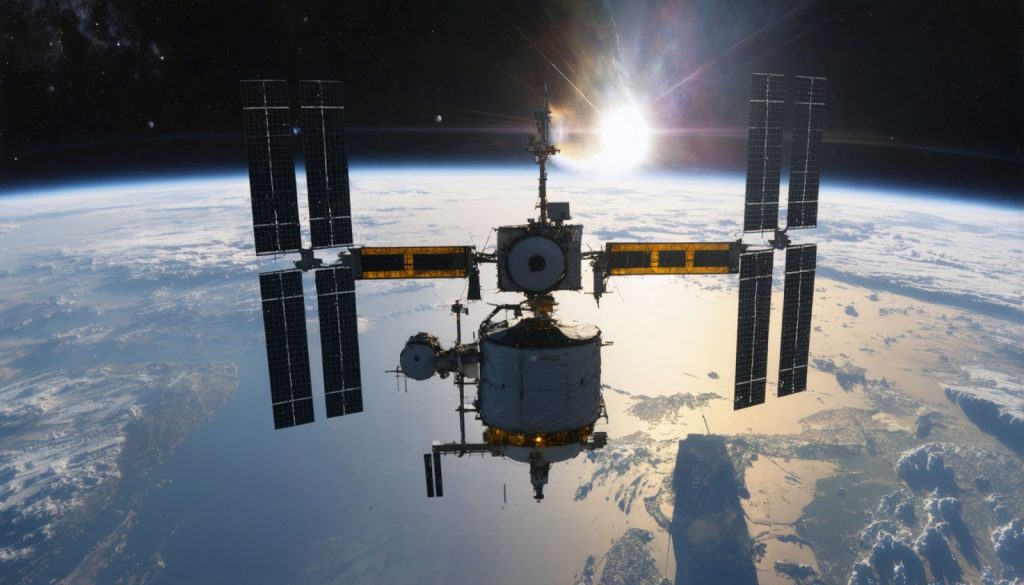
- Satellite deployments signify the blend of engineering prowess and visionary goals, aimed at reshaping our view of Earth.
- Modern satellites extend beyond communication, monitoring climate, resources, and providing crucial data for scientists and policymakers.
- Real-time satellite imagery aids disaster response and boosts agricultural efficiency, demonstrating tangible benefits to society.
- The driving force behind satellite missions is progress in understanding and preserving our planet through technological advancements.
- The overarching mission encompasses not just exploration, but also environmental stewardship and global connectivity.
- Every satellite launch is more than hardware deployment; it’s a journey of potential and shared human insights.
Amidst the vastness of space, the silent ballet of satellite deployment unfolds—a precise dance of engineering and ambition. Picture a sleek rocket piercing the horizon, fiery thrusters propelling it beyond Earth’s blue grasp. This is not merely a launch; it’s a mission—one that marries technology with dreams, promising to reshape how we see our world from above.
Embarking on this celestial journey, a satellite’s deployment is a marvel of human ingenuity. Once released into its orbital position, the satellite awakens, stretching solar panels in a graceful salute to the sun. This moment marks the culmination of years of meticulous planning and innovation. Engineers and scientists spend countless hours simulating every phase, ensuring the satellite’s seamless transition from terrestrial assembly to its new home in the cosmos.
In recent deployments, the focus has moved beyond communication. Modern satellites serve as vigilant guardians of Earth, tracking climate patterns and natural resources with unprecedented accuracy. Each satellite’s sensors, finely tuned and honed, capture snapshots of atmospheric conditions, sea-level changes, and even urban development. These celestial observers gather invaluable data, feeding insights back to scientists, policymakers, and environmentally conscious citizens alike.
The power of satellite imagery extends further than scientific analysis. Picture rescue teams navigating disaster-stricken regions using real-time images delivered by satellites. Envision farmers relying on precision agriculture tools that optimize crop yields by analyzing satellite-fed data. These scenarios transform the orbital journey into tangible benefits for all.
But what fuels the magic of a satellite deployment? It’s the pursuit of progress and the imperative to understand our planet better. Every deployment carries a message—a clarion call to harness technology not just for exploration, but for preservation and enhancement of life on Earth.
As we gaze skyward, let’s appreciate the silent sentinels above, reminding us that the universe—though vast and formidable—holds keys to nurturing our fragile world. Satellite deployments are more than technical feats; they are stepping stones towards a future where knowledge lights the way.
The takeaway? Each deployment isn’t just a launch of hardware. It’s an embrace of potential, a testament to human vision alongside the stars, and a promise of shared insights—keeping us connected to both our planet and each other. As we venture further into space, may we always remember to look back, understanding Earth a little more with every launch, every orbit, and every new dawn.
Unlocking the Cosmos: How Satellite Deployment Transforms Earth Observation
The Bold Horizon of Satellite Deployment
Satellite deployment represents a remarkable intersection of precision engineering and ambitious vision. Beyond merely sending a rocket into space, this sophisticated operation lays the groundwork for enhancing our understanding of Earth and advancing numerous fields. Let’s delve deeper into the facets of satellite technology that propel us towards a brighter future.
The Anatomy of Satellite Launch and Deployment
Every satellite launch is meticulously planned to ensure success. While the original article discussed the initial stages, here are further detailed steps and considerations involved in satellite deployment:
1. Pre-launch Simulations: Engineers conduct extensive simulations to anticipate and troubleshoot potential issues during the launch and deployment phases. This process involves vibration testing, thermal modeling, and system validation.
2. Launch Vehicle Selection: Depending on the satellite’s purpose and orbit, a suitable launch vehicle (rocket) is chosen. Launch vehicles vary in payload capacities and are selected to match the weight and destination of the satellite.
3. Orbit Selection: Each satellite is deployed into a specific orbit best suited for its mission—be it geostationary for constant Earth observation or low Earth orbit for detailed monitoring.
4. Deployment and Calibration: Once in orbit, the satellite undergoes a deployment phase where mechanical components like solar panels and antennas are extended. Following this, systems are calibrated to ensure optimal functionality.
Satellite Technology: Expanding Horizons Beyond Communication
Modern satellites serve diverse purposes, extending far beyond traditional communication roles. Here are some specific use cases:
– Climate Monitoring: Instruments like spectroradiometers and radar altimeters provide essential data on atmospheric chemistry, sea surface temperatures, and ice sheet dynamics. Satellites such as those in the Sentinel constellation supply this crucial data.
– Mapping and Land Use Monitoring: High-resolution imagery supports urban development planning and conservation efforts by offering a macroscopic view of land use changes and deforestation.
– Disaster Management: Real-time imagery enables rapid assessment and management of natural disasters, assisting rescue operations and humanitarian aid delivery.
Pros and Cons of Satellite Deployment
Understanding the benefits and limitations of satellite deployment is critical:
Pros:
– Global Coverage: Satellites provide unparalleled global data access.
– Precision and Accuracy: Modern sensors capture highly accurate data, essential for scientific research and policy-making.
– Longevity: Most satellites are designed for ten to fifteen years of service, ensuring long-term data collection.
Cons:
– High Costs: Launch and maintenance costs are significant, often limiting accessibility to well-funded programs or nations.
– Space Debris: Increased satellite launches contribute to the growing problem of space debris, urgently needing international attention and regulation.
Market Trends and Industry Forecasts
The satellite industry is rapidly evolving. Key trends include:
– Miniaturization: Small satellites (CubeSats) are becoming more prevalent, offering a cost-effective option for launching new missions.
– Private Sector Involvement: Companies like SpaceX and Blue Origin are revolutionizing access to space with reusable launch vehicles, reducing costs and opening new market opportunities.
According to a report by the Satellite Industry Association, the global satellite industry is projected to reach $277 billion by 2025, driven by advancements in satellite technology and growing demand for high-resolution data.
Actionable Recommendations
For aspiring engineers or space enthusiasts, here are a few tips:
– Stay Updated: Follow leading space agencies like NASA and ESA for the latest developments in space technology.
– Engage with Online Courses: Platforms like Coursera offer courses on space technology and satellite engineering.
– Participate in Space Hackathons: Engage in events like Space Apps Challenge to collaborate and innovate.
As we continue to explore the cosmos, satellites remain crucial in illuminating our path, encouraging us to balance exploration with stewardship of our planet. For more information on space-related innovations, check out NASA.



